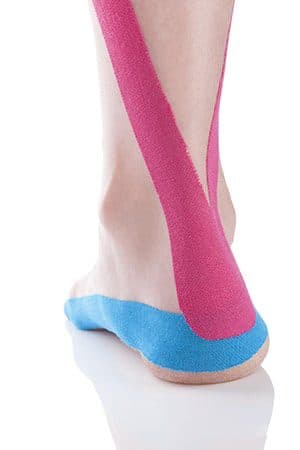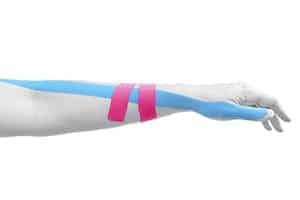Kinesio Taping was developed by Dr Kenzo Kase as way of supporting an injured or inflamed muscle or joint.
Kinesio Tape is the brightly coloured tape, often seen on the leg or arm of a professional sports person.
Traditional taping can be very supportive for acutely injured or unstable joints, but it limits normal range of movement and so inhibits performance or normal activities of daily life. This is one of the reasons Kinesio Tape is preferred by amateur and professional athletes – it supports without affecting performance. it can be used effectively alongside IAST and deep tissue massage.
Kinesio Taping Treatment

It has become very popular in the last decade or so, and is widely used within the general population. Many people learn how to tape themselves, so they can get additional support and pain relief for their problem area whenever they engage in their chosen sporting activity.
Because Kinesio Tape has the advantage of not restricting movement, the injured tissue is supported and is less painful, but the patient retains full range of motion.
Dr Kenzo Kase designed it to mimic the elastic quality of skin. It can stretch to between 55% and 60% of its original length. It is made of 100% cotton and contains no latex, which minimises the chances of skin irritation or allergic reaction.
Kinesio Tape is breathable and allows moisture to escape from the skin. The elastic tape is applied to the affected muscle or joint to help reduce the strain. The direction in which the tape is applied pulls the skin in a specific direction that can help reduce the stress to inflamed and painful tissues. This supports the tissues until they can heal naturally.
Kinesio Tape can be applied in various configurations including “I” “Y” or “X”. One common application of Kinesio Tape is the offloading of the postural muscles of the neck, upper back and shoulders.
Kinesio Taping in Notting Hill
Postural ache and tension headaches are very common in people who spend many hours in front of a computer screen, this is one of the most common reason why kinesio tape is applied at Natural Moves in Notting Hill.
Kinesiotape can lift the skin, aiding lymphatic drainage. Lymph is a filtrate of blood that is rich in immune cells. It is the fluid that seeps through the blood vessels into the tissues. The immune cells clear up cellular debris and the byproducts of the inflammatory/healing process. Lymph then travels in small low-pressure vessels back to the larger blood vessels that lead to the heart. The collected products and impurities are processed by lymphatic cells within the lymph nodes along the way. Kinesiotape assists this process and so speeds up the healing process.

Kinesiotape can be left on for 3-5 days before it loses its elastic properties. It can be worn in the bath or shower as long as care is taken to pat it dry rather than rub.
Kinesio Tape’s Applications

Kinesio Tape has different properties depending on the way it is applied. For example, mechanical correction may be desirable in patients whose joints move in a way that is not ideal, or whose static posture deviates from ideal alignment.
Mechanical correction is achieved with 50-75% stretch of the tape. The theory is that receptors are stimulated by the pull exerted on the skin by the Kinesio Tape, which in turn prompts modification of the muscular control of movement and body position.
Kinesio Tape can be applied to utilise its spring like qualities. This is done when a therapist wants to limit the motion of a particular joint in a specific direction. In this case, the Kinesio Tape is used at 50-100% stretch.
Lymphatic drainage is promoted by arranging the tape in a fan-like configuration. This is done close to the lymph nodes. The stretch on the tape should be 0-15%.
Swollen tissues can be lifted using Kinesio Tape. The tape is arranged so the skin puckers. This assists fluid flow and reduces the swelling. The tension used is 20-50% of full stretch.
Tightness or misalignment of the fascia is treated by manually realigning the tissues and then taping with 25-50% of full stretch.
Injured ligaments or tendons can be treated with 50-75% stretch to stimulate receptors and offer mechanical support.
